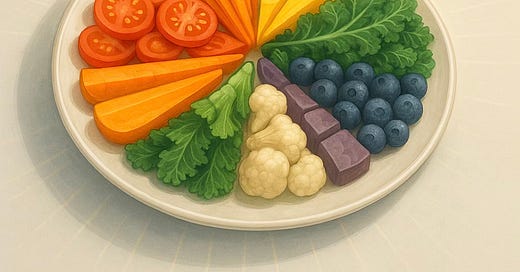Color Your Plate, Fuel Your Fate
Why Eating Vibrantly Might Be the Most Powerful Health Decision You Ever Make
Let’s play a quick game.
Open your fridge.
Now count the colors.
If all you see is beige, bread, pasta, rice, cereal, yogurt, maybe a tired banana, you’re not alone. But your cells? They’re starving for conversation.
Because here’s the truth:
Food doesn’t just fuel your body. It talks to it. And color speaks the loudest.
Nutrients Aren’t Just Fuel—They’re Instructions
In the 1990s, nutrition science hit a turning point. Researchers realized something profound: nutrients act like messengers. They don’t just fill you up, they tell your genes what to do.
Some switch inflammation off.
Others activate detox pathways.
Some charge up your mitochondria, the little engines that power every cell in your body.
And the best messengers? They’re colorful.
Each Color Sends a Message
Think of food like code. Each color programs your body differently.
Red (beets, strawberries, tomatoes) calms inflammation and boosts circulation.
Purple (blueberries, cabbage, eggplant) protects your brain and memory.
Orange (carrots, sweet potatoes) strengthens your eyes and immune system.
Green (spinach, kale, broccoli) supports detox and cellular repair.
White (garlic, onions, mushrooms) fights microbes and boosts immunity.
These pigments aren’t just pretty—they’re phytonutrients, and they act like software updates for your cells.
No color? No update.
Just static.
The Real Danger of a Beige Diet
During World War II, governments distributed rations: white bread, margarine, canned meat, potatoes. Calorically adequate, but colorless.
And people got sick.
Not from too little food.
From too little variety.
They had energy, but no micronutrients. The result? Fatigue. Weak immunity. Slow healing.
That same pattern is back, but now it’s hidden in takeout containers and ultra-processed snacks.
We’re eating more than ever, and still undernourished.
Want to Make It Stick? Don’t Rely on Willpower.
Behavior science is clear: long-term habits are built through environment and cues, not motivation.
Wendy Wood’s research shows that people eat more fruits and vegetables when they’re visible, easy to grab, and ready to go.
Translation?
Don’t hope for a craving—create a cue.
Put the chopped peppers front and center. Keep berries at eye level. Make a rainbow easier than a box of crackers.
Here’s your new mantra:
Three colors by noon. Five by dinner. Every day.
Let’s say it again…Three colors by noon. Five by dinner. Every day.
Make it a habit. Watch your energy shift.
Does It Really Change Your Fate?
Yes. Down to the cellular level.
Your mitochondria, the energy factories inside your cells, thrive on colorful, plant-based compounds. The more colors you eat, the more resilient your energy system becomes.
You gain metabolic flexibility, the ability to switch fuel sources easily, stay sharp, burn clean, and age slower.
This isn’t hype. It’s physiology.
The Rainbow, Decoded
Want to know exactly what each color does? Here’s your cheat sheet:
Red
Examples: Tomatoes, beets, strawberries
Key nutrients: Lycopene, betalains
Benefits: Lowers inflammation, protects DNA, supports heart health
Orange
Examples: Carrots, squash, mango
Key nutrients: Beta-carotene
Benefits: Immune strength, eye and skin support
Yellow
Examples: Pineapple, turmeric, corn
Key nutrients: Curcumin, lutein, zeaxanthin
Benefits: Mood, vision, brain clarity
Green
Examples: Broccoli, spinach, kale
Key nutrients: Sulforaphane, chlorophyll, folate
Benefits: Detoxification, DNA repair, mitochondria support
Purple / Blue
Examples: Blueberries, eggplant, cabbage
Key nutrients: Anthocyanins, resveratrol
Benefits: Brain protection, circulation, longevity
White / Tan
Examples: Garlic, onions, mushrooms
Key nutrients: Allicin, quercetin, selenium
Benefits: Immune boosting, antimicrobial, enzyme support
Each bite is a signal. Each color is a command.
The Bottom Line
This isn’t about chasing perfection.
It’s about changing your inputs, because they change your outcomes.
Your plate is a control panel. Color is how you program it.
So here’s your assignment:
Color your plate. Fuel your fate.
Every color is a vote for your vitality.
And every meal is a chance to heal.
Ready to Put This Into Practice?
If you’re serious about rewiring your biology one plate at a time, this is where information becomes transformation.
Paid subscribers get instant access to the full printable worksheet, including:
A simple Color Audit to spot what's missing in your meals
A Daily Color Tracker to help you hit your “3 by noon, 5 by dinner” target
A visual habit design plan (based on behavior science) to make vibrant food the default
Weekly reflection prompts to track energy, digestion, mood, and momentum
A repeatable framework you can use week after week to build real, lasting change
No guesswork. No fluff. Just a clear, science-backed tool to make eating colorfully effortless and effective.
Upgrade now to get the worksheet—and all past and future tools, guides, and habit challenges.
Your mitochondria will thank you.
Click here to upgrade now.





